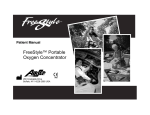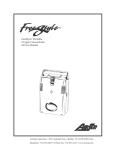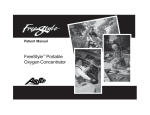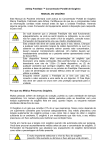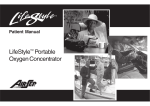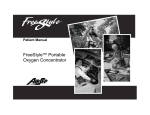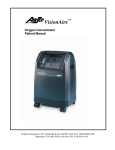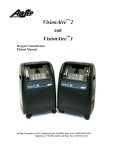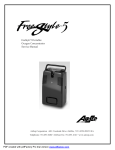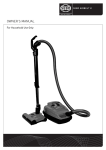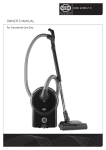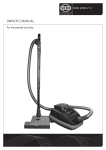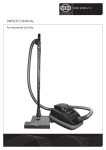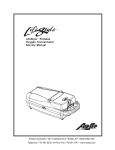Download FocusTM Portable Oxygen Concentrator Service Manual
Transcript
Focus Portable Oxygen Concentrator Service Manual TM AirSep Corporation ● 401 Creekside Drive ● Buffalo, NY 14228-2085 USA Telephone: 716-691-0202 ● 24-Hour Fax: 716:691-4141 ● www.airsep.com MN171-1 Rev. A 02/14 Expedited Product Warranty Check service is always at your fingertips with AirSep: http://www.airsep.com/Support/Warranty_Information.aspx OR In the US or Canada, dial 866-873-9277 AirSep® is a registered trademark of AirSep Corporation. ■ Focus™ is a trademark of AirSep Corporation MN171-1 Rev. A 02/14 Table of Contents Section 1.0 Introduction 1.1 1.2 1.3 1.4 1.5 Equipment Provider Responsibility Important Notice and Symbol Explanations Definitions of Symbols Focus Specifications Focus Classifications Section 2.0 Operation Check and Test of Oxygen Concentration 2.1 2.2 Description of Operation Operation Check Section 3.0 Operating Instructions 3.1 General Instructions 3.1.1 Connecting to Focus’s Power Inlet 3.1.2 Power Sources Available to Focus 3.1.3 Nasal Cannula 3.1.4 Battery Charging 3.1.4.1 Charging Focus Battery While Using the Power Supply with Focus 3.1.4.2 Charging the Optional AirBelt™ Section 4.0 Alarm System Table #1 - Alarm / Priority 4.1 Start-up 4.2 Battery Status MN171-1 Rev. A 02/14 4.3 4.4 Low Battery Discharged Battery 4.5 4.6 Cannula Disconnect Performance Warning 4.6.1 Focus Capacity Exceeded 4.6.2 General Malfunction Section 5.0 Oxygen Concentration Test and Specification Section 6.0 Routine Maintenance / Instructions to Patient 6.1 Alarm / Service Indicator Section 7.0 Equipment Provider Maintenance 7.1 7.2 7.3 7.4 7.5 Equipment Provider Routine Maintenance Compressor Servicing Record Maintenance Infection Control Cleaning and Preparing for New Patient Use Section 8.0 Service Note: At this, all repairs must be performed at AirSep’s Service Department. If your Focus requires service, contact your Customer Service representative to obtain an RGA and instructions for return to AirSep. Section 9.0 Troubleshooting 9.1 Troubleshooting Chart MN171-1 Rev. A 02/14 1.0 Introduction 1.1 Equipment Provider Responsibility All Equipment Providers of the Focus™ Portable Oxygen Concentrator must assume responsibilities for handling, operational check-out, patient instruction, and maintenance. These responsibilities are outlined below and throughout this manual. This unit is not to be used for life support. Geriatric, pediatric, or any other patients unable to communicate discomfort while using this unit may require additional monitoring. Patients with hearing and/or sight impairment(s) may need assistance with monitoring alarms. As an Equipment Provider, you must do all of the following: ■ Inspect the condition of each Focus unit immediately upon delivery to your business location. Note any sign of damage, external or internal, on the delivery receipt, and report it directly to both the freight company and AirSep Corporation immediately. ■ Check the operation of each Focus unit before delivery to a patient. Always operate the unit for a minimum of 10 minutes, and check that the oxygen concentration level is within specifications, as described in Section 5 of this manual. ■ Deliver Focus units only to patients authorized by a physician’s prescription. Focus must not be used as a life-supporting device. ■ Instruct patients how to use Focus in conjunction with the Patient Manual. ■ Instruct patients to notify their physicians and/or Equipment Providers if they experience any signs of discomfort. ■ Be available to service each patient at any time. ■ Maintain Focus in accordance with Section 7. ■ Repair components and replace parts only as outlined in this manual. Use only AirSep parts for replacement in Focus Oxygen Concentrators. MN171-1 Rev. A 02/14 1.2 Important Notice and Symbol Explanations As you review both the Focus Patient Manual and this Focus Service Manual, pay special attention to the WARNING, CAUTION, and NOTE messages. They identify safety guidelines or other important information as follows: Warning – Describes a hazard or unsafe practice that if not avoided can result in severe bodily injury, death or property damage Caution – Describes a hazard or unsafe practice that if not avoided can result in minor bodily injury or property damage Note – Provides information important enough to emphasize or repeat NO SMOKING signs should be prominently displayed in the home or wherever Focus is in use. Proper information about the dangers of smoking in the presence of medical oxygen should be relayed. MN171-1 Rev. A 02/14 1.3 Definitions of Symbols Symbols are frequently used on equipment and/or the manual in preference to words with the intention of decreasing the possibility of misunderstanding caused by language differences. Symbols can also permit easier comprehension of a concept within a restricted space. The following table is a list of symbols and definitions used with the Focus Portable Oxygen Concentrator. Symbol Description ON (power switch on) Warning – Describes a hazard or unsafe Symbol Description OFF (power switch off) practice that if not avoided can result in severe bodily injury, death or property damage Class II Equipment, double insulated Caution – Describes a hazard or unsafe Complies with the 93/42/EEC directive drawn up by the approved organization No. 0459 practice that if not avoided can result in minor bodily injury or property damage Note – Provides information important enough to emphasize or repeat Safety agency for CAN/CSA C22.2 No. 601.1 M90 for medical electrical equipment Consult the accompanying documents Keep unit and accessories dry Use no oil or grease Proper disposal of waste of electrical and electronic equipment required No smoking Do not disassemble Type BF equipment Consult instructions for use Oxygen outlet connection to the cannula Do not expose to open flames Caution: Federal law (USA) restricts this for sale or rental by or on the order of a physician or licensed health care provider. Do not block fan MN171-1 Rev. A 02/14 1.4 Focus Specifications Oxygen Concentration:* 90% oxygen - 3% / +5.5% Dimensions: 6.4 in. high x 4.8 in. wide x 2.5 in. deep (16.4 cm high x 12.2 cm wide x 6.1 deep) Weight: Concentrator 1.75 lb (0.8 kg) Battery 0.53 lb (0.2 kg) Optional AirBelt Battery 1.8 lb (0.8 kg) Power: Universal Power Supply: AC Power Supply: Input # 1_100 – 240 VAC (1.5 Amps max at 120 VAC 50/60 Hz) DC Power Supply: Input # 2_11-16 VDC 5.0 Amps max Battery duration (Rechargeable lithium Battery) Battery: 1 ½ hours (per battery) Optional AirBelt Battery: 4 hours Battery recharge time: 4 hours; optional AirBelt: 3 ½ hours Warm-up time: 2 minutes Battery cycle life: Approximately 300 cycles, then 80% capacity or below. Audible alarms and pulse visual indicators: Start-up – audible and visual Pulse flow – visual Cannula disconnect- audible and visual Breath rate alarm – audible and visual General malfunction – audible and visual Service required - visual Low battery - audible and visual Battery condition – battery level indicator on battery Normal operating temperature: 41°F to 104°F (5°C to 40°C) Storage temperature: -2°F to 140°F (-20°C to 60°C) Temperature range: * Based on an atmospheric pressure of 14.7 psi (101 kPa) at 70°F (21°C) * Operating unit outside of normal operational temperature range can affect performance. MN171-1 Rev. A 02/14 1.5 Focus Classifications Type of protection against electric shock: Class II Protection from electric shock is achieved by double insulation. Degree of protection against electric shock: Type BF Equipment providing a particular degree of protection against electric shock regarding 1) allowable leakage current; 2) reliability of protective earth connection (if present). Not intended for direct cardiac application. Independent testing for Medical Electrical Equipment Standard: Tested by QPS Testing Services NA Inc. to be in compliance with, IEC 60601-1 Medical Electrical Equipment – Part 1: General Requirements for Safety 2nd edition 1988, A1 1991, A2 1995. Tested by QPS to be in compliance with applicable requirements of the Standard, CAN/CSA C22.2 No. 601.1-M90 Medical Electrical Equipment – Part 1: General Requirements for Safety, General instruction No. 1; Supplement No. 1; 1994 Amendment 2 – 1998 and General instruction No. 2 November 2003 Protection against potential electromagnetic or other interference between the equipment and other devices. Tested by Ultratech Group of Labs to be in compliance with: EN 60601-‐1-‐2:2007 (EMC) (2nd Edition), Medical Electrical Equipment, Part 1: General Requirements for Safety-Collateral Standard: Electrical Compatibility - Requirements and Tests RTCA-DO160F Airborne Equipment, Sec. 21, Emission of Radio Frequency Energy CISPR 11:2009 +A1:2010 / EN 55011:2009, Class B Group 1, “Industrial, Scientific, and Medical (ISM) Equipment” FCC Part 15, Subpart B – Class B Unintentional Radiators Method of cleaning and infection control allowed: Please refer to “Cleaning, Care, and Proper Maintenance” section of this Focus Patient Manual. Degree of safety of application in the presence of flammable anesthetic gases: Equipment not suited for such application. Mode of operation: Continuous duty. MN171-1 Rev. A 02/14 2.0 Operation Check and Test of Oxygen Concentration 2.1 Description of Operation Air enters the Focus Oxygen Concentrator through an external air intake. This air enters the compressor via a suction resonator that quiets the compressor’s suction sound. The pressurized air then exits the compressor to a two-way solenoid feed valve that directs the air into one of two sieve beds that contain molecular sieve. The unique property of molecular sieve enables it to physically attract (adsorb) nitrogen when air passes through this material, thereby separating the nitrogen from the oxygen in ambient air. There are two sieve beds: While one produces high-concentration oxygen, the other is purged of the nitrogen it adsorbed (collected) while it made oxygen. Oxygen exits the product tank after first passing through the integrated product filter. In addition to the molecular sieve beds that allow oxygen to be separated from air, Focus contains an Oxygen Conserving Device (OCD) valve that controls delivery of high-concentration oxygen to the patient at the point in the breathing cycle when the patient starts to inhale. Focus delivers a gas consisting of 90% (+5.5%/-3%) oxygen at a pulse flow rate equivalent to 2 LPM (liters per minute) constant flow. 2.2 Operation Check AirSep tests every Focus Oxygen Concentrator thoroughly after manufacture. You must perform the following test to ensure that no damage occurred in shipping or handling. 1. Open and inspect all cartons upon delivery. Unpack the unit and remove it from the carton. Inspect the unit itself for damage. If the exterior of a unit’s carton is damaged, or if the unit itself is damaged, note this on the freight bill signed by the driver. 2. Connect the power supply or battery to the unit. Turn the Focus unit on by pressing the power switch to the on position (l). Refer to Section 3 for operating instructions. 3. Check to see that the following sequence occurs: a. When Focus is turned on, [A one-second, audible alarm sounds to indicate start-up. The green and red LED’s on the control panel will alternate on/off for (10) seconds. After the (10) second start up is complete the green LED will be illuminated indicating that the Focus is ready to be used.] b. The compressor runs. c. Exhaust air flows from the unit. 4. Perform an oxygen concentration test, as described in Section 5. MN171-1 Rev. A 02/14 3.0 Operating Instructions 3.1 General Instructions It is important that patients thoroughly understand how to operate AirSep’s Focus unit. This enables proper treatment as prescribed by a qualified, licensed physician. You must explain that the purpose of this therapy is to alleviate symptoms. If patients experience any discomfort or if the unit alarms, they must notify their Equipment Provider and/or physician immediately. You, as the Equipment Provider, are responsible to ensure that each patient receives the Focus Patient Manual. Explain each step in the operation of the unit to the patient with reference to the patient manual. Instruct patients that AirSep recommends that Focus should be used while sleeping only under the direction of their clinician. In addition, some patients who tend to be mouth-breathers may benefit from the use of a chin strap. 3.1.1 Connecting to Focus’s Power Inlet Locate the arrow marking at the top of the connector. Insert connector (Figure 1) into the Focus power inlet (Figure 2) with the arrow on the side of the connector facing outward. Do not force the connector into the power inlet, as it can be inserted only one way. This ensures that neither the unit nor the power accessories are damaged. Turn the Focus unit on by pressing the power switch to the on position (l). Focus units Power Inlet Focus units power connector Figure: 2 Figure: 1 \ 3.1.2 Power Sources available to Focus 3.1.2.1 F i g u r e 4 Focus operates from four different power sources. NOTE: Always connect to the Focus power inlet first before connecting to a power supply. 1) Connecting Focus to AC electrical power When you are near an AC outlet, you may choose to operate Focus with the universal power supply rather than the battery.Connect the cord on the power supply labeled as DC OUT To Focus into the Focus unit’s power inlet,as shown in Figure 3. Do not force the plug, as it should be inserted only one way. Plug the 3-prong AC cord from the power supply into any standard outlet. Turn the Focus unit on by pressing the power switch to the on position (l). MN171-1 Rev. A 02/14 Focus unit’s Power Inlet DC OUT to Focus Figure: 3 2) Connecting Focus to a DC power source F i g u r e The universal power supply can also be used to operate the Focus unit from any 12-Volt DC 4 power source. For example: to an automobile, (boat, motor home, etc.) with a 12-Volt DC outlet. Connect the power supply cord labeled DC OUT To Focus into the Focus unit’s power inlet, as shown in Figure 3. Place the DC accessory adapter on the end of the DC power cord. Connect the other end into the power supply input connection labeled Accessory DC IN (see Figure 4). You can then connect the DC power cord (with adapter attached) into the 12-Volt DC power source. Do not force the cords, as they can be inserted only one way. Turn the Focus unit on by pressing the power switch to the on position (l). DC OUT to Focus F i g u r e DC accessory adapter 4 Connect to Focus DC power cord Accessory DC IN MN171-1 Rev. A 02/14 Figure: 4 F 3) Connecting Focus with the Battery, as shown: Before using the battery, check that it has a sufficient charge. The battery is equipped with a gauge (Figure 9) to indicate the level of battery charge (25100%). To check the level of charge of the battery, press the button on the battery’s keypad. The battery gauge/indicator(s) LEDs to the left of the button illuminate to indicate the level of battery charge (25-100%). Connect the switch end of the battery cord into the Focus unit’s power inlet only, as shown in Figures 5 and 6.Connect the other end into the battery. Do not force the cords, as they can be properly inserted only one way. Refer to the instructions on charging the battery in the Battery Charging section. Focus units Power Inlet Battery Gauge Belt / Shoulder Strap clip Figure: 5 Figure: 6 Figure 11 Figure 11 4) Connecting Focus with the Optional AirBelt™ Battery F Check that the AirBelt is sufficiently charged. It requires approximately 3 ½ ighours to completely charge. AirBelt (Figure 7) is equipped with a fuel gauge to indicate the level uof battery charge r (25-100%). To check the level of charge, press the button on the AirBelt keypad. The battery e gauge/indicator(s) illuminate to indicate the level of battery charge (25-100%). Connect the 4 interface cable (Figure 8) into the AirBelt, then plug the other end of the interface cable into the Focus, as shown in Figure 9. For proper orientation of the connector, see Connecting to the Focus Power Inlet section. Turn the Focus unit on by pressing the power switch to the on position (l). Refer to the instructions on charging the battery in the Battery Charging section. AirBelt battery charge level (25-100% Figure: 7 AirBelt battery MN171-1 Rev. A 02/14 F i g u r e Figure: 8 AirBelt to Focus cord Figure: 9 AirBelt battery with Focus F i g AirBelt to 4 Focus connection F i g u r e 4 3.1.3 Nasal Cannula A nasal cannula with tubing are used to deliver oxygen from the Focus unit to the user. The tubing is connected to the unit’s oxygen outlet (Figure 10). Focus Power Inlet Connect the Cannula to Focus’s Oxygen Outlet Figure: 10 AirSep recommends a nasal cannula with 7 ft (2.1 m) of tubing, AirSep Part No. CU002-1 or suitable cannula. Other lengths of non-kinking / star channel cannula can be used for a total length of up to 25 ft (7.6 m) maximum. When Focus is operating but does not sense breathing for 15 minutes, a constant alarm sounds, and the amber alarm light illuminates simultaneously. If this occurs, check the connection from the cannula to the Focus unit, make sure that the nasal cannula is positioned properly on your face, and ensure that you are breathing through your nose. (Your physician may recommend the use of a chin strap if needed.) If the alarm condition continues, change to another source of oxygen as available, and contact your Equipment Provider. Always follow the cannula manufacturer’s instructions for proper use. Consult your licensed health care provider to determine how often the cannula should be replaced. Cannula tubing must be non-kinking, which can be used for a total length of up to 25ft (7.6cm) maximum. Ensure the cannula is fully inserted and secure. This ensures that the Focus unit can properly detect inspiration for oxygen delivery. MN171-1 Rev. A 02/14 3.1.4 Battery Charging To check the level of charge of the battery, press the button on the battery’s keypad. The battery gauge/indicator(s) illuminate to indicate the level of battery charge (25-100%). 3.1.4.1 To charge the Focus battery while using the power supply with Focus 1a) Using AC Power: Follow the instructions in the Connecting Focus to AC electrical power section. 1b) Using DC Power: Follow the instructions in the Connecting Focus with the Battery section. 2) Connect the battery cord without the on / off switch into the power supply outlet marked DC OUT To Battery. Connect the other end to the battery. Note: The battery is charging whenever the unit operates on AC or DC power. • The Focus battery will completely recharge from its fully depleted state in approximately four hours, whether or not the unit is in use on AC or DC power. • While charging a fully discharged battery, the LED will continue to blink until 25% capacity is reached. The LED will then turn solid. • Each of the four LEDs, 25% -100%, will blink as stated above, then turn solid when they reach their capacity. • When all LEDs illuminate solid, the battery is fully charged and the LEDs will remain solid for a period of time, then all four LEDs will turn off. • Wherever storing Focus battery for an extended period of time, ensure that the battery state of charge (SOC) is not depleted or stored at 100%. Both these conditions can result in unrecoverable capacity loss. The recommended SOC is 25% to 50% for long-term storage. The recommended storage temperature is 23oC +/- 2oC. The Battery can be recharged from the power supply while using Focus AC or DC power. F i g u r e 4 Figure: 11 MN171-1 Rev. A 02/14 3.1.4.2 Charging the Optional AirBelt To charge the AirBelt battery: 1) Release safetycap from end of the AirBelt cord. 2) Connect the AC/DC power supply (included with the AirBelt Accessory kit) to the end of AirBelts power cord as shown in Figure 12. 3) Connect the AirBelt power supply to an AC electrical outlet to recharge. AirBelt PW009-2 AC/DC Power Connecting the AirBelt cord to the power supply cord Supply AC/DC Power Supply PW009-2 AC/DC Power Supply Figure 12: AirBelt Battery Charging set up PW009-2 AC/DC Power Supply Replace safety cap on AirBelt cord when not in use. Do not attempt to charge the optional AirBelt with the Focus power supply or the damaged. Use only the AirBelt power supply provided to charge AirBelt. • • • • F i g AirBelt u r e can be 4 The Focus AirBelt will completely recharge from its fully depleted state in approximately 3 ½ hours. While charging a fully discharged battery, the LED will continue to blink until 25% capacity is reached. The LED will then turn solid. Each of the four LEDs, 25% -100%, will blink as stated above, then turn solid when the battery reaches it’s capacity. When all LEDs illuminate solid, the battery is fully charged and the LEDs will remain solid for a period of time, then all four LEDs will turn off. The incorrect use of AirBelt can cause it to get hot, ignite, and may cause serious injury. Be sure not to pierce, strike, step on, or drop the battery, or otherwise subject the battery to strong impacts or shocks. Do not store Focus or AirBelt in a very hot automobile or in other similar, high- or low-temperature environments. Operating or storing the AirBelt outside the normal temperature range can affect its performance. (Refer to the Specifications section in this manual.) MN171-1 Rev. A 02/14 Storing your AirBelt for extended periods of time at high temperatures or with a fully charged or completely discharged battery can degrade its overall battery life. Depending upon the temperature of the Focus battery, it can take several minutes for the charging cycle to start after connecting to power. This is a normal condition and is intended for safe charging. AirBelt does not need to be fully discharged before recharging. It is recommended to charge it after each use. If the AirBelt power supply remains connected when it is fully charged, the four LEDs will turn off within ½ hour. 4.0 Alarm System An audible alarm sounds simultaneously with a visual alarm if the Focus units battery is low, senses no inspiration, or if performance is outside specifications. If an alarm sounds observe which lights are on. The visual and audible alarm conditions are explained in detail below. ALARM / PRIORITY VISUAL AUDIBLE (Buzzer) 1.)High Temperature (Red) 3 - half second flashes and a 5 second pause 2.) Battery Warning (Amber) 1 – half second flash and a 5 second pause 3 half second beeps and a 5 second pause (beep, beep, beep) 1 – half second beep and a 5 second pause (beep) 2 – half second beeps and a 5 second pause (beep, beep) Continuous beep 2 – half second beeps and a 5 second pause (beep, beep) 3 half second beeps and a 5 second pause (beep, beep, beep) No beep Battery Shutdown (Amber) 2 – half second flash and a 5 second pause 3.) No Inspiration 4.) Malfunction (Amber) Solid Red) 2 – half second flashes and a 5 second pause 5.) Breath rate exceeded (Amber) 3 - half second flashes and a 5 second pause 6.) Service Alarm (Amber) Solid Table # 1 Alarm / Priority MN171-1 Rev. A 02/14 4.1 Start-Up A one-second, audible alarm sounds to indicate start-up. The green and red LED’s on the control panel will alternate on/off for (10) seconds. During this (10) seconds both feed and waste valves are open. After the (10) second start up is complete the green LED will be illuminated indicating that the Focus is ready to be used. 4.2 Battery Status To check the level of charge of the battery, press the button on Focus battery keypad. The battery gauge / indicator(s) LEDs next the button illuminate from 25-100% to indicate the level (capacity) of the internal battery. At less than 25% capacity, the 25% LED blinks. 4.3 Low Battery Focus unit indicators: As the battery power approaches a low level, the amber light on the Focus unit will flash on for ½ second with a 5-second pause and simultaneously, a ½ second alarm sounds with a 5-second pause. Following the battery warning indicators, if action is not taken, the unit will shut down. This will be indicated when the amber light flashes 2 times with a 5-second pause and simultaneously, a ½ second alarm sounds 2 times with a 5 second pause. Battery indicator: The green light indicator on the battery gauge light flashes. When this occurs, the patient is instructed to, connect Focus to a DC power outlet or to an AC power outlet, or change to another source of oxygen immediately. The level of battery charge is indicated by the battery gauge/indicator(s). You can also check the SOC (state of charge) at any time by depressing the button. When the unit is connected to AC or DC power outlet, you may simultaneously charge the Focus battery supplied with the unit while running the unit 4.4 4.5 Discharged Battery § Battery shutdown indicator on Focus control panel: When the battery is fully discharged, the unit shuts down. Before this occurs the amber light flashes 2 times with a 5-second pause and simultaneously, a ½ second alarm sounds 2 times with a 5 second pause. § Battery indicator: The green light indicator on the battery gauge light flashes. When this occurs, the patient is instructed to, connect Focus to a DC power outlet or to an AC power outlet, or change to another source of oxygen immediately. The level of battery charge is indicated by the battery gauge/indicator(s). You can also check the SOC (state of charge) at any time by depressing the button. When the unit is connected to AC or DC power outlet, you may simultaneously charge the Focus battery supplied with the unit while running the unit Cannula Disconnect (No inspiration detected) When Focus is operating but does not sense breathing for 15 consecutive minutes, a constant alarm sounds, and the amber alarm light illuminates simultaneously. If this occurs, check the connection from the cannula to the Focus unit, make sure that the nasal cannula is positioned properly on your face, and ensure that you are breathing through your nose. (Your physician may recommend the use of a chin strap if needed.) If the alarm condition continues, change to another source of oxygen as available, and contact your Equipment Provider MN171-1 Rev. A 02/14 4.6 Performance Warning The performance of Focus can be affected by two conditions. 1) If the user’s breathing rate causes the Focus unit’s capacity to be exceeded. 2) The second condition that can result in decreased performance is a general malfunction (i.e. High temperature, High or Low pressure). 4.6.1 Focus Capacity Exceeded When the patient’s breathing rate has caused the capacity of Focus to be exceeded, an alarm sounds 3 times every ½ second with a 5 second pause, and the amber alarm light illuminates simultaneously (See Table 1). When this occurs, the concentration of oxygen that Focus is supplying is outside of the unit specifications. The patient is advised to reduce any physical activity, reset alarm by turning unit off and back on, and then if necessary change to another source of oxygen as available, and contact your Equipment Provider 4.6.2 General Malfunction If Focus has a general malfunction, an audible alarm sounds and the red alarm light illuminates (See Table 1). If this alarm condition occurs, the patient is advised to change to another source of oxygen as available, and contact your Equipment Provider 5.0 Oxygen Concentration Test and Specification To ensure that Focus’s oxygen output is within specification, you must perform an oxygen concentration test. Test the unit upon delivery to a patient and at periodic intervals. Equipment Providers, based upon their own expertise and documentation, may establish and implement their own protocol to check oxygen concentration. The interval established may be longer or shorter than 90 days, AirSep’s default time period for providers who do not choose to establish their own protocol. 5.1. Connect the Focus Oxygen Concentrator to an AirSep-supplied AC power supply (AirSep Part No. PW019-1). 5.2. To activate the unit’s test mode: 5.2.1 Focus unit off before 4 seconds expires. 5.2.2 Turn the unit on and then off again during the 10 second start up sequence. The user has a maximum of 6 seconds to complete this task. 5.2.3 Repeat step 5.2.2 5.3. 5.2.4 Turn the unit on and let it remain on. Verify Focus is pulsing by observing the intermittent green LED. MN171-1 Rev. A 02/14 When the unit pulses, you should be able to hear the pulse of oxygen and see the LED turn off momentarily. Allow Focus to run for 5 minutes before recording the oxygen concentration of the unit. 5.4. With a short length of tubing 12 in. (30 cm), connect a calibrated Teledyne Analytical Instruments oxygen analyzer (Model AX-300) or Fujikura Oxygen Analyzer (Model FCX-HOM or FCX-OM3). to the oxygen outlet on the Focus concentrator. Turn on the analyzer and record the unit’s concentration. The concentration specification in test mode is 87% or greater. 6.0 Routine Maintenance Instruction for Patient To ensure accurate output and efficient operation of the unit, the patient must contact the Equipment Provider for inspection/service when the alarm/service indicator illuminates. 6.1 Alarm/Service Indicator The Focus unit should be serviced after every 5,000 hours of use. This should include replacing the compressor felt filter, a check of oxygen concentration, etc. When the unit has reached 5,000 hours of use, an amber LED will illuminate on the right side of the unit’s control panel. Instruct patients to notify the Equipment Provider when this happens. If the oxygen concentration of the unit is below 87%, the system’s operating pressure should be measured to verify the compressor is functioning within specification. If the system pressure is below 19 psig (131 kPa), make sure that the unit is leak-free by testing all tubing connections and fittings with leak-testing solution. If no leaks are present, replace the compressor. AirSep does not recommend the sterilization of this equipment. 7.0 Equipment Provider Maintenance 7.1 Equipment Provider Routine Maintenance The Focus unit includes one filter and a compressor that require scheduled maintenance or replacement. To ensure that the output of oxygen is within specification, you must perform an oxygen concentration test. (Refer to Section 5, “Oxygen Concentration Test and Specification,” of this manual.) Test the unit upon delivery to a patient and at periodic intervals. Equipment Providers, based on their expertise and documentation, may establish and implement their own protocol to check oxygen concentration. The interval established may be longer or shorter than 90 days, AirSep’s default time period for providers who do not choose to establish their own protocol. 7.2 Compressor Servicing As the Equipment Provider, you are responsible for monitoring the life of the compressor, which must be checked at every 5,000 hours of use. MN171-1 Rev. A 02/14 7.3 Recording Maintenance As the Equipment Provider, you should record all routine maintenance and repairs performed on the Focus unit, including hours and dates of service. 7.4 Infection Control With growing concern about possible cross infection from home oxygen equipment from one home care patient to another, a clarification on this topic is necessary. The organisms of most concern are M.Tuberculosis, HIV, and Viral Hepatitis. These are potentially pathogenic. Tuberculosis can survive outside the human body, but its mode of transmission is by droplet nuclei. When infected individuals cough, they release droplet nuclei into the air, and these carry the Tuberculosis organism. These droplet nuclei may be breathed in by another person, but prolonged exposure to the infected person is usually necessary for infection to occur. HIV and Viral Hepatitis are both viruses that are not living cells themselves but can duplicate when in a living “host” cell. Both of these organisms are usually passed on by person-toperson contact, and both need to be in the human body to survive. Once outside the body, viruses do not survive. 7.5 Cleaning and Preparing for New Patient Use When you remove Focus from a patient’s home, always detach and dispose of the used nasal cannula. Clean the exterior of Focus with a mild household cleaner applied with a damp cloth or sponge. Pay special attention to the oxygen outlet for the cannula connection to make sure it remains free of dust, water, and particles. Be careful not to get any liquid into the interior of the unit. Next, clean the exterior with a common chemical disinfectant before any other patient uses the unit. Do not use liquid directly on the Focus unit to clean it. Do not use liquid directly on the Focus unit to clean it. A list of undesirable chemical agents includes but is not limited to, the following, according to the plastics manufacturer: alcohol and alcohol-based products, concentrated chlorine-based products (ethylene chloride), and oil-based products (Pine-Sol, Lestoil). These are NOT to be used to clean the plastic housing on Focus, they can damage the units plastic. Allow Focus to air dry, and then re-test oxygen concentration before you return the unit to your inventory. _______________________________________________________________ *Make the bleach solution a 1:100 dilution of 5.25% sodium hypochlorite. Mix one part household bleach (e.g., Clorox with 99 parts cold tap water) to measure the solution easily, take ¼ cup of household bleach, and mix it with a gallon of cold tap water. Allow the mixture to sit on potentially contaminated surfaces for 10 minutes. AirSep does not recommend the sterilization of this equipment. MN171-1 Rev. A 02/14 8.0 Service 8.1 Note: At this, all repairs must be performed at AirSep’s Service Department. If your Focus requires service, contact your Customer Service representative to obtain an RGA and instructions for return to AirSep. 9.0 Troubleshooting Problem Unit does not turn on, and AC power supply is properly connected to a wall outlet. Unit does not turn on, and DC power supply is properly connected to an automobile, RV, accessory outlet. General malfunction; alarm is activated. Battery duration is less than per specification. Possible Cause Solution Wall switch power is off. Turn on wall or outlet switch. No power to unit. Reset household circuit breaker. Unit temperature has exceeded battery operating temperature 5 to o 40 C. Allow unit to cool before starting. AC power supply is not properly connected to Focus. Check connection from the AC adapter to Focus. Defective AC power supply. No power at DC outlet Replace AC adapter. Check fuse for DC outlet. DC power supply is not connected to accessory outlet or not connected to Focus. Connect DC power supply to outlet of automobile after ignition is started. Defective DC power supply Replace power supply. Unknown Unit overheats and will shut down. Check air inlet and exhaust vents for obstruction. Return to AirSep. Clear obstruction at air inlet and exhaust. Unknown Return To AirSep Battery not fully charged. Ensure that battery charges for at least 3-1/2 hours and all (4) LEDs are lit solid. Battery has been stored in a discharged or 100% charged state for prolonged period of time or stored in a very high temperature environment. Replace battery. Battery reached cycle life. Replace Battery. Battery temperature has exceeded battery operating temperature 5 to o 40 C. Allow battery to cool before starting. Focus is not turned on. Turn Focus on. Battery is depleted Replace battery . Unit does not start on battery. MN171-1 Rev. A 02/14 Problem Battery does not charge. Oxygen concentration is below specifications in test mode. Unit does not deliver oxygen. MN171-1 Rev. A 02/14 Possible Cause Solution Battery temperature has exceeded battery operating temperature 5 to o 40 C. Allow battery to cool before charging. Battery is defective. Replace battery AC adapter connector is defective or contact pin is bent. Replace battery Defective AC adapter Unknown Replace AC adapter. Return to AirSep. Cannula kinked or not properly connected. Check cannula and the cannula connection. Unknown Return to AirSep.
























